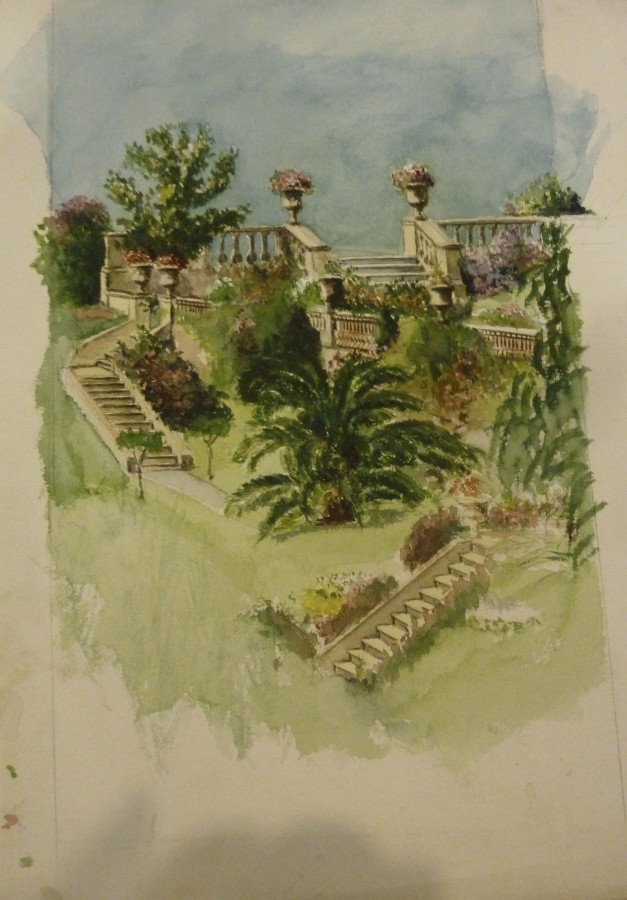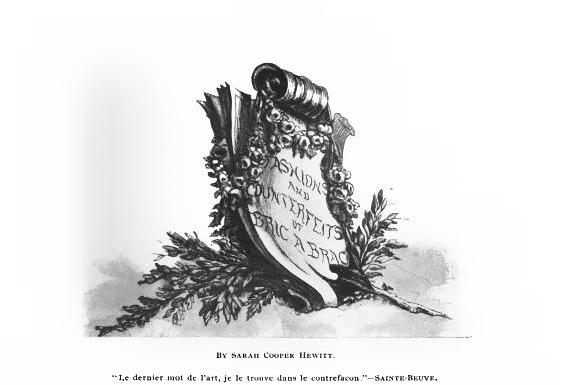Last month’s snippet, Meet the Hewitts: Part Two, focused on the education and family life of the
young Hewitt children. Now we move on to Sarah and Eleanor’s formative years.
Margery Masinter, Trustee, Cooper-Hewitt, National Design Museum and MA’93, History of Decorative Arts and Design, Parsons the New School for Design
Sue Shutte, Historian at Ringwood
The Hewitt Sisters Collect and Travel: 1880’s

Sarah, in walking suit by House of Worth, Paris. Carte de Visite photograph by Roseti. Courtesy of Ringwood Manor

Eleanor. Portrait by Antonia de Banuelos. Cooper-Hewitt, National Design Museum
It takes a string of adjectives to describe the personalities of Sarah and Eleanor as they entered their twenties. They were smart, fun-loving, witty, and social. They were competitive athletes; aggressive and methodical in their varied pursuits; accomplished linguists, prolific writers, skilled musicians, and talented artists. They cared about women’s education and employment opportunities. Sarah was more like her father, with a sharp wit, intense need for order, and strong likes and dislikes. Her passport details her height at a statuesque 5’ 6 3/4." Eleanor, who has been described as petite, inherited her mother’s milder, kindly manner and patient devotion to intricate needlework and gardening.
Sarah and Eleanor treasured their freedom. They chose not to marry, and cherished childhood friendships with other independent and privileged women, including the poet Carolyn Durer, the theatrical producer Elizabeth “Bessy” Marbury and her partner, actress and decorator Elsie de Wolfe. Their older sister Amy, who was born with a hare-lip (later fixed), has been described as sweet-tempered, shy and retiring, but with a practical sense of responsibility. Amy was 30 when she married Dr. James O. Green (1842-1924) in 1886 and had two children, Norvin (1893-1955) and Eleanor (1895-1966), who, after her marriage, was known as the Princess Viggo.

James O. Green. Courtesy, Cooper Union Library

Amy and James Green in Paris. Courtesy, Cooper Union Library
The sisters naturally became educated in the arts of decoration. Not only were they active members of the Cooper Union Ladies Advisory Committee to the Women’s Art School, they avidly studied Abram’s collections of art books and illustrated newspapers of the London and Paris expositions, and they shared Amelia’s passion for beautiful needlework and decorative objects.
Eleanor, in 1919, remembers
two little girls with pigtails tightly braided . . . were being taken regularly by their
father to all places where objects of art were being exhibited before their sale at
auction. . . . the auction rooms were Leavitts . . .and the American Art Association.
The bric-a-brac trade was then in its infancy in New York . . . and they put two and
two together by talking with the few art dealers into whose shops they went.
George A. Leavitt (1822-1880) maintained the largest fine arts and book auction house in New York, and the American Art Association began conducting auctions in 1885. The international dealer Henry J. Duveen (1855-1918) opened his firm’s New York office in 1886, and, so claims Eleanor, “made his first sale to Miss Hewitt.”

Sarah, Amy, and Eleanor. Photograph in gondola, Venice. Cooper-Hewitt, National Design Museum
Every year the Hewitt family traveled in Europe. Abram combined business with pleasure while Amelia and her daughters indulged in shopping for art, bibelots and the latest in Paris fashion. Sarah and Eleanor were introduced to knowledgeable dealers and museums, and began to buy books, prints, drawings and rare textiles. It is a fact that the European purchases of their parents contributed to the foundation of their future museum. Their journals from this time are lost, and the photograph above of them in a gondola is the only one we have of their travels in Europe.
Eleanor and Sarah pasted these sketches and watercolor drawings, evidence of their artistic talent, into their scrapbooks to record places visited and their interest in architecture and design.

On left, Alhambra, Spain, 1884. On right, Venice, Italy, 1886. Courtesy of Cooper Union Library

Garden watercolor. Couresty of Cooper Union Library

Design watercolor, Courtesy of Cooper Union Library
In 1892, Sarah wrote an article for Cosmopolitan magazine titled, “Fashions and Counterfeits of Bric-a-Brac.” Here, she shared the unusual experience she had to tour an immense counterfeit facility outside of Paris. It is clear that Sarah’s knowledge of the decorative arts along with her social status afforded her this unusual opportunity. Her writing helped to open the eyes of early collectors to the vast amount of high quality reproductions that were beginning to flood the American antiques market. Her article concluded with this admonition:

Let each collector take for a motto, 'Caveat Emptor,' and remember this final warning. . . 'Be thorough unbelievers about objets d’art. . . . Above all do not count on lucky finds.'
Interactive Timeline of the Cooper Hewitt World
Sources:
The Making of a Modern Museum, by Eleanor G. Hewitt, 1919. Online at https://archive.org/details/makingofmodernmu00hewi
Abram S. Hewitt, by Allan Nevins, 1935, Harper & Brothers, New York
“Fashions and Counterfiets of Bric a Brac,” by Sarah Cooper Hewitt, Cosmopolitan Magazine, June 1892.
Coming up next month:
Entertainments and Paris Fashion
The Hewitt Family in the Gilded Age
